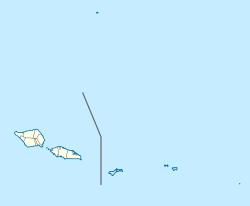Uafato
| Uafato Uafato |
||
|---|---|---|
|
|
||
| Coordinates | 13 ° 57 ′ S , 171 ° 31 ′ W | |
| Basic data | ||
| Country | Samoa | |
| A'ana | ||
| ISO 3166-2 | WS-AA | |
Uafato is a village on the northeast coast of Upolu in Samoa . The village is of national and international importance as a unique cultural and conservation area.
geography
The village is located in the political district (itūmālō) Vaʻa-o-Fonoti and is part of the Uafato Conservation Area . It is part of a cluster of nine small settlements on Fagaloa Bay . Additionally, it is in the area of the Fagaloa Bay - Uafato Tiavea Conservation Zone , an area with dense rainforest of the Tropical Rainforests of Samoa , interesting topography, waterfalls and coral reefs.

Uafato is the easternmost of the villages in the bay and nestles on the coast between the sea and the rainforest. The village is accessed by a narrow country road from Fagaloa Bay. Like most villages in Samoa, the people of Uafato maintain a traditional lifestyle and culture, which is determined by the Faʻa Samoa (The Samoan Way), the Matai (chiefs) and the va tapuʻia - interaction with the surrounding nature. The rainforest remains the primary source of local food. The forests around the village are home to one of the largest remaining populations of indigenous hardwood trees of the kind ifilele ( Intsia bijuga ), which play an important role in culture with many uses, including architecture and carving.
The village is a center of traditional carving and there are workshops specially geared towards tourists where the making of kava bowls, war clubs and other carvings is demonstrated. The women make finely woven mats, fans and other items that are an important source of income for the families. The reputation of the local carvers has grown since the turn of the millennium and the Uafato carvers also supply the craft market in the capital Apia . Most of the techniques that are used date back to before contact with Europeans.
The distance to the capital is given as one and a half hours and day tours are offered. There are also some Beach Fale that can be rented for overnight stays.
Uafato Conservation Area
The Conservation Area is ancestral land owned by the Uafato families. The sanctuary includes the entire village, Fagaloa Bay and approximately 1,300 acres of woodland. In this area numerous rare birds and several species of mammals including two bat species and 22 bird species, including the endangered were detected tooth-billed pigeon ( Didunculus strigirostris , "Samoan pigeon"). The tooth pigeon is the national bird of Samoa and is called "Manumea" in the local language. The initiative for a sanctuary came from the chiefs and villagers after the cyclones of 1991 that destroyed a large part of the village. The Council of Chiefs approached a private environmental organization, the O Le Siosiomaga Society . A year later, the Uafato Conservation Area was established with financial support from the Pacific Regional Environment Program (SPREP).
“The term 'conservation' is not new to us. One purpose of the reserve is to keep international logging societies away from Uafato because our survival depends on the forest. It's a matter of common sense. "
Alaifue Lisale died in 2010 and Vaisa Laumea (66 years old) was appointed the new High Chief of Uafato at Christmas 2009 .
mythology
The name Uafato is explained through various narratives . One story tells of people piling up to build Lufasiaitu 's house. This required 100 human posts. The men were forced to step on the neck of the lower man (among other things) to form a post. This also explains the chief title 'Faleselau' ( fale = house and selau = one hundred). This title therefore refers to the hundred pillars of Lufasiaitus' house.
Another story tells that the supreme god Tagaloa lives in the ninth heaven above Uafato.
Web links
Individual evidence
- ↑ Planning for a sustainable resource management at Uafato by CEO Tuʻuʻu Ieti Tauleʻalo . In: Ministry of Natural Resources & Environment, Government of Samoa . Retrieved November 10, 2009.
- ↑ Fagaloa Bay - Uafato Tiavea Conservation Zone. In: unesco.org. UNESCO World Heritage Center, accessed April 8, 2020 .
- ↑ Conservation in Samoa ( English ) In: New Zealand Trust for Conservation Volunteers . Retrieved November 27, 2009.
- ^ Ancestral Ways, Modern Voices: The Samoan Path to Conservation . In: United Nations Development Program, Samoa . Retrieved November 10, 2009.
- ↑ The term 'conservation' is not new to us. One purpose of the conservation area is to keep international logging companies out of Uafato, because we depend on the forest for our survival. It is a matter of common sense. High Chief Alailefue Lisale , aged 69.

